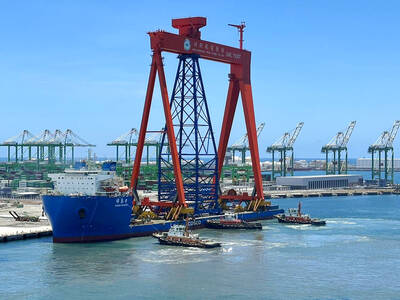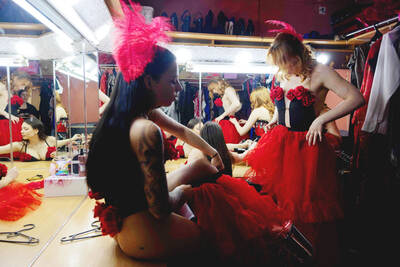The National Museum of History has recently mounted several notable exhibitions on China’s history. The Smiling Kingdom: The Terra-Cotta Warriors of Han Yang Ling (微笑彩俑—漢景帝的地下王國), for example, provided an in-depth look at societal changes through funerary objects excavated from the mausoleum of an early Han Dynasty emperor.
But there have been misses, too. A Drop in the Ocean: Modern Contemporary Chinese Calligraphy and Painting Exhibition (滄海一粟—近現代書畫展) threw up hundreds of calligraphic scrolls and ink paintings without adequately explaining the exhibits’ context.
Legends of Heroes: The Heritage of the Three Kingdoms Era (英雄再起─大三國特展), a new exhibition on the museum’s first floor, is of the latter category.
“By presenting the era from different angles and on different levels, and by adopting wide-ranging approaches, it should be possible to present a comprehensive picture of military affairs, technology, economy, daily life, art [and] religion ... in the Three Kingdom era, as well as the influence that the history of the Three Kingdoms has exerted on later generations,” the show catalog says.
What we get, however, is a romantic glimpse of the period that lacks historical rigor. Aside from focusing on the era’s heroes, the exhibition only superficially links the age’s rulers and the societies they dominated.
The museum borrowed 146 artifacts from 32 museums in China, including sculptures, seals, calligraphy, ceramics and gold and silver jewelry excavated from 70 historical sites dating back to the kingdoms of Wei (魏), Shu (蜀) and Wu (吳).
Legends of Heroes focuses on three broadly chronological themes: official histories of the era; the period as depicted in the Ming Dynasty novel Romance of the Three Kingdoms (三國演義); and later representations of the era’s heroes, whether found in the hand scrolls and wood carvings of the Ming Dynasty or contemporary animation and computer games.
The museum uses the Qing Dynasty Albums of Emperors and Famous Officials to present the stories of the Three Kingdom’s movers and shakers, including the tyrannical though highly organized Wu kingdom founder Cao Cao (曹操) and brave Shu general Guan Yu (關羽).
But the connection between the historical figures and the objects on display is never made explicit, with visitors left to fill in the blanks. The exception is the section on Zhuge Liang (諸葛亮, also known as Kong Ming (孔明), which illustrates the relationship between his curious
personality and the inventions that appeared during his reign.
What a shooting and hunting scene or a celadon pot in the shape of a frog has to do with Zhao Yun’s (趙雲) bravery or Zhang Fei’s (張飛) courage is anybody’s guess.
One of the highlights is the Romance of the Three Kingdoms section that includes scrolls depicting the Battle of the Red Cliff, which provide valuable insights into how different artists from various points in time viewed that period.
The contemporary display items, however, are barely worthy of a museum. One room houses four monitors that show computer games based on the Three Kingdoms, while another room houses an interactive display of cartoon characters of Kong Ming and Guan Yu.
“How cute!” exclaimed a young viewer.
The flashy and forgettable use of technology is made even more disappointing because interactive media have been used to great effect in Huaxia Artifacts (館藏華夏文物展), an ongoing exhibition of ancient Chinese artifacts on the museum’s third floor.
Too many of the objects on display are only tangentially related to the overall theme of heroism and its subsequent depictions in art and popular culture. Limiting the objects to the exhibition’s theme would have created a more coherent and less frustrating experience.

The canonical shot of an East Asian city is a night skyline studded with towering apartment and office buildings, bright with neon and plastic signage, a landscape of energy and modernity. Another classic image is the same city seen from above, in which identical apartment towers march across the city, spilling out over nearby geography, like stylized soldiers colonizing new territory in a board game. Densely populated dynamic conurbations of money, technological innovation and convenience, it is hard to see the cities of East Asia as what they truly are: necropolises. Why is this? The East Asian development model, with

June 16 to June 22 The following flyer appeared on the streets of Hsinchu on June 12, 1895: “Taipei has already fallen to the Japanese barbarians, who have brought great misery to our land and people. We heard that the Japanese occupiers will tax our gardens, our houses, our bodies, and even our chickens, dogs, cows and pigs. They wear their hair wild, carve their teeth, tattoo their foreheads, wear strange clothes and speak a strange language. How can we be ruled by such people?” Posted by civilian militia leader Wu Tang-hsing (吳湯興), it was a call to arms to retake

This is a deeply unsettling period in Taiwan. Uncertainties are everywhere while everyone waits for a small army of other shoes to drop on nearly every front. During challenging times, interesting political changes can happen, yet all three major political parties are beset with scandals, strife and self-inflicted wounds. As the ruling party, the Democratic Progressive Party (DPP) is held accountable for not only the challenges to the party, but also the nation. Taiwan is geopolitically and economically under threat. Domestically, the administration is under siege by the opposition-controlled legislature and growing discontent with what opponents characterize as arrogant, autocratic

When Lisa, 20, laces into her ultra-high heels for her shift at a strip club in Ukraine’s Kharkiv, she knows that aside from dancing, she will have to comfort traumatized soldiers. Since Russia’s 2022 invasion, exhausted troops are the main clientele of the Flash Dancers club in the center of the northeastern city, just 20 kilometers from Russian forces. For some customers, it provides an “escape” from the war, said Valerya Zavatska — a 25-year-old law graduate who runs the club with her mother, an ex-dancer. But many are not there just for the show. They “want to talk about what hurts,” she